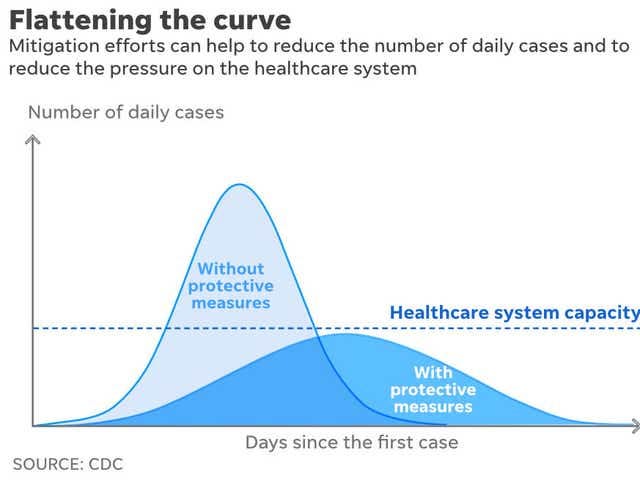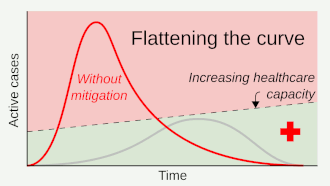COVID AMA #5
As COVID cases fall and much of the country starts to fully “open up,” we still have a lot of unanswered questions. Hopefully I can provide some useful answers this week.
Explain this curve business to me. Have we “flattened” it, whatever that means?
The “flatten the curve” graphic may be the most successful example of data visualization that the world has ever seen. We’ve all seen this picture by now:

The whole concept is that if a pandemic spreads through society too rapidly, critically ill patients will overwhelm the capaicty of the healthcare system. “Flattening the curve” with protective measures like social distancing, masks, and voluntary lockdowns reduces the rate of spread through society, theoretically preventing the healthcare system from being overwhelmed.
The corollary process is “raising the line” in order to increase health care capacity. This can be visualized here:

But focusing discussion simply on flattening the curve misses important points.
Protective measures that flatten the curve prolong the need for protective measures if the virus isn’t adequately contained and we don’t have new treatments.
Half hearted protective measures just prolong our societal suffering without reducing the number of infected people
At the beginning of the pandemic, there was a lot of focus on the basic reproduction number, or the R0 (pronounced R nought) which is basically a measure of how many people each infected person will infect.
But the R0 isn’t a fixed number. Although it’s related to the infectivity of the virus, the R0 is malleable based on our protective measures. With aggressive containment, it is possible to get the R0 down well below 1, which means that an outbreak can be contained since each infected person infects less than one additional person.
Containment isn’t just social distancing. It’s also contact tracing, testing, and isolation - things that we can’t do as individuals and require competent public health organizations to perform.
This is why South Korea has done so well, essentially solving their societal outbreak.
But half hearted strategies, like we’ve been doing, means that we get the worst of both worlds. We get economic devastation and a simmering pandemic with a curve that seems like it’s going to stay flattened - without extinguishing - for a much longer time.
I’ve had the virus. You’ve said that I should continue to wear a mask, but for how long? Would I be able to visit people who are still in quarantine if it’s been more than a month since my symptoms?
You’re probably fine and probably won’t transmit the virus. I’m assuming that having been infected means some degree of immunity (although the details of this remain murky). You can certainly go about your regular life. But I’m going to continue to emphasize the mask thing. Just wear a mask and protect the people around you. Return your shopping cart. Be a good member of society.
I remember reading that the virus had a worse impact on individuals in Wuhan with certain blood types and I was wondering if there had been any more research on that?
There is certainly an association with blood type and risk of infection.
Blood type refers to specific proteins that your blood cells have on their surface.
When you are blood type A, it means that your blood cells express the “A” protein.
If you’re blood type B, you express the “B” protein.
People who are blood type O don’t express either A or B
People who are AB express both A and B
You make antibodies to whichever proteins you don’t have. So someone who is type O makes antibodies to both A and B. Someone who is B makes antibodies to A. And so on.
There’s some research suggesting that antibodies to the A protein block the ability of the SARS-CoV-2 virus to enter our cells and infect us.
I’ve talked before in this newsletter about the road to hell being paved with biologic plausibility - the concept that just because something makes sense with our current understanding of the biology doesn’t mean it will pan out when we actually test the hypothesis.
I think that blood type and risk of infection is one of the areas that we should be cautious on extrapolating the basic research to draw real conclusion.
The jury remains out on this one.
Can you explain plasma donation? For example, my son had the virus, and he donated plasma. They said that it would help three patients. Would he be able to donate it to me and would that act like a vaccine to prevent me from getting the virus?
The idea of plasma donation is that in order to get rid of the virus, you need to develop antibodies to it. These antibodies hang out in your plasma, the fluid in blood that isn’t made of blood cells.
By donating plasma, you’re potentially providing antibodies to the virus.
Receiving donated antibodies isn’t a silver bullet. There’s certainly promise to this treatment, and it’s worth studying in clinical trials.
We don’t know how long the antibodies you receive will last in your system. Maybe they stick around for week or a month, but maybe they’re more transient. It’s certainly not a strategy for lifelong immunity - you need to produce your own antibodies in order to achieve this.
The only way to produce your own antibodies it to have your immune system exposed to either the virus (AKA get infecteD) or a piece of the virus (AKA a vaccine).
That’s all for now, please keep sending me your interesting questions.



